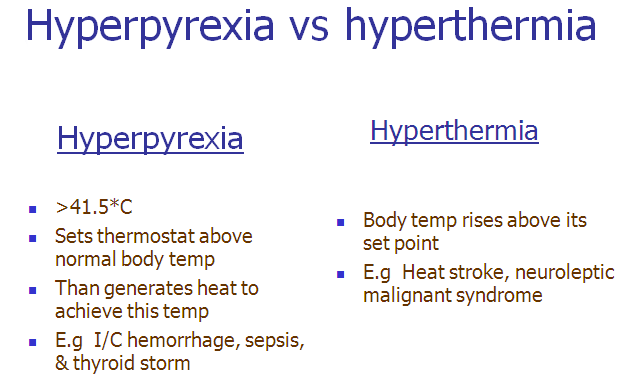Fever is an elevation of body temperature above the normal circadian range as the result of a change in the thermoregulatory center located in the anterior hypothalamus
Max normal oral temp in morning is 37.2*C (98.9*F)
Max normal oral temp in evening is 37.7*C (99.9*F)
Rectal temp is 1*F higher
Given these criteria, an a.m. temp >98.9*F or a p.m. temp of > 99.9*F would define fever.
Febrile response is a complex physiological reaction to an illness, involving a cytokine mediated rise in core temp, the generation of acute phase reactants, & the activation of numerous physiologic, endocrinologic and immunologic systems
Pattern of fever
Sustained fever/continuous fever
Typhoid, pneumococcal
Intermittent fever
Pyogenic abcess, malaria
Remitting fever
Viral infections. mycoplasma
Relapsing fever –Lymphoma, Dangue
Fever – pulse Disparity– Typhoid, legionella
Drug fever
Current evidence
Indicates fever is a primitive immunologic response with long phylogenetic history
Studies show that fever & its direct consequences are adaptations and natural selection
- Specifically to fight infections both by increasing the phagocytic activity—Neutrophils
- Optimizing cytotoxic activity of Lymphocytes
Cost of fever
For each 1*C rise:
- Increase in 13% O2 consumption
- Increase in caloric needs
- Induction of temp infertility in men
- Accelerate muscular catabolism
- Antipyretics frequently used without compelling medical reason
- In most febrile illness there is no evidence that fever is detrimental & that antipyretics offer any benefit
Whom to be treated first ?
- Pregnant women— a hypermetabolic state can be dangerous
- Children with hx of febrile seizures
- Patients who cannot tolerate a rise in intracranial pressure
- Physicians should treat fever only when the expected benefit outweigh the possible risks
Pathogenesis
With >37.2*C the body responds:
- Muscle shivering, vasoconstriction & piloerection–chills
- Thereby body conserving temp followed by
- Vasodilatation, muscle spasm—-sweeting
Exogenic toxins/pyrogens (Bacteria, viruses, parasites)
Endogenic toxins (cytokines, bacterial products IL-1, IL-6, TNF-a)
- Both affect on thermosensitive neurons on Hypothalamus
- Thereby increasing heat production & decreasing heat loss
- Temp rises till the new set point
- This info is conveyed by the temp of the blood flowing around hypothalmus
- The pyrogens trigger synthesis of prostaglandins of group E from arachdonic acid (PGE2) which through cyclic AMP resets the central thermostat
- NSAIDS/antipyretics inhibit PGE2 thru inhibiting Cyclo-oxigenase pathway
- Glucosteroids inhibit all pyrogens thru lipo-oxygenase pathway (IL & TNF-a)
- Cytokines stimulate immune response at 39.5*C
- They also recruit neutophils & enhance their functions Indicating fever as a positive factor
Diagnostic approach
History taking
Complete physical examination
Investigations
Management
Complete physical examination
Do not overlook:
- Rash or skin nodules
- Eyes
- Optic fundi
- Upper airways
- Rectal examination
Investigations
- CP with ESR, C-reactive protein
- Chest radiograph
- Malaria films, Urinalysis
- Blood culture, urine culture, faeces culture
- Sputum RE & Culture
- Ultrasound exam of abdomen
- Serological tests for viruses, bacteria, fungus and parasites
- LFTs, RFTs
- Blood sugar, CPK, Bone biochemistry
- ECG/Echocardiogram
- Biopsies- Liver, bone marrow
- Immunological tests- auto-antibodies, PCR, TB serology
 howMed Know Yourself
howMed Know Yourself









